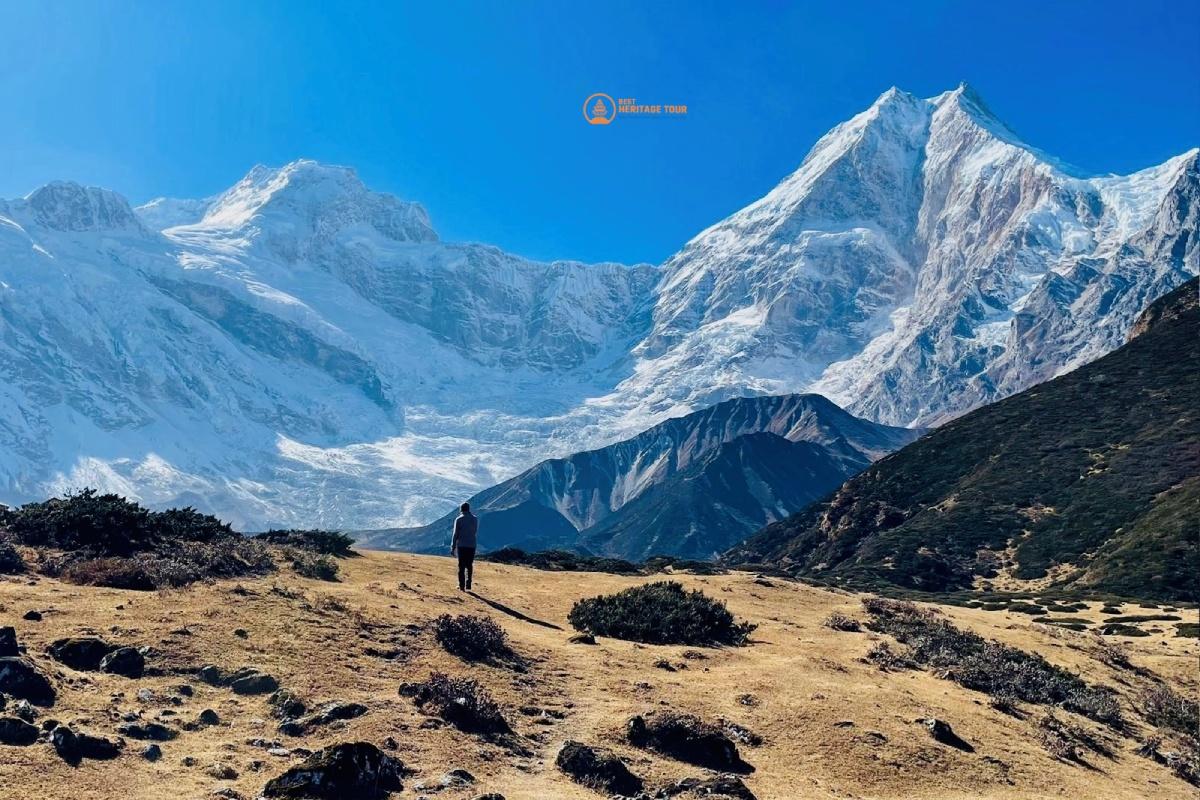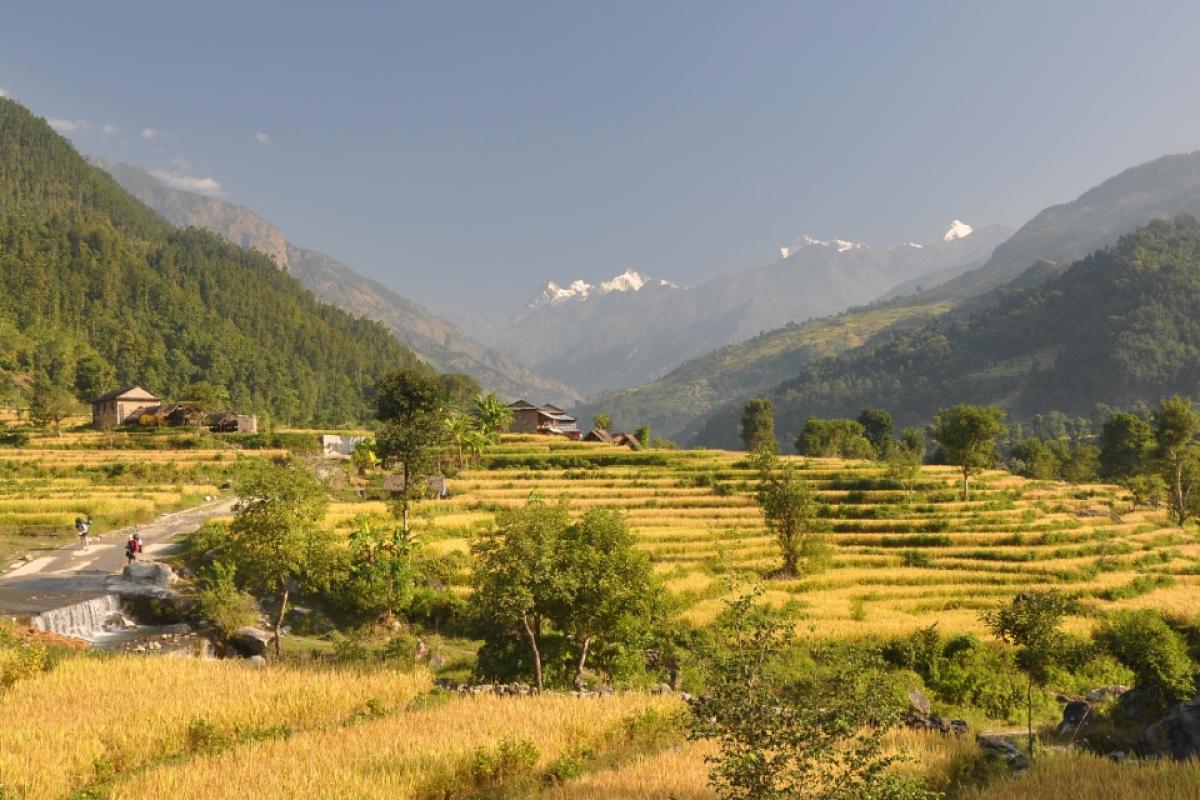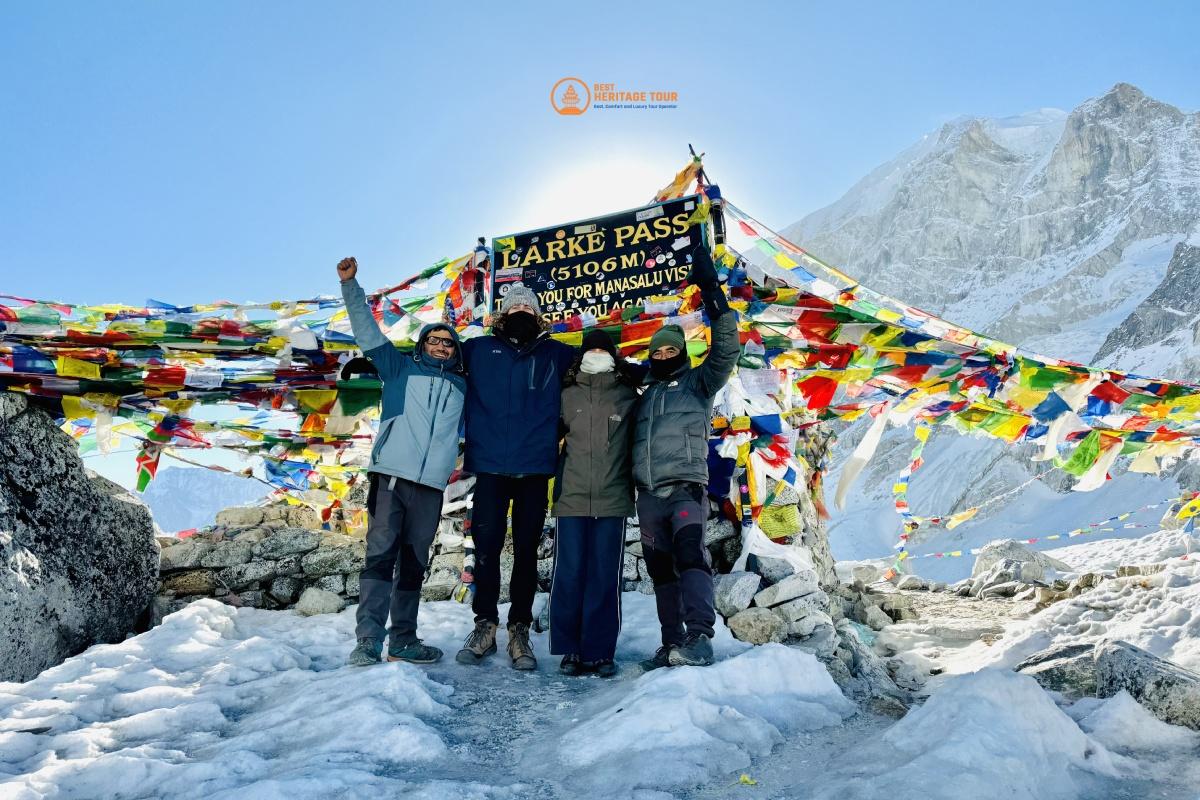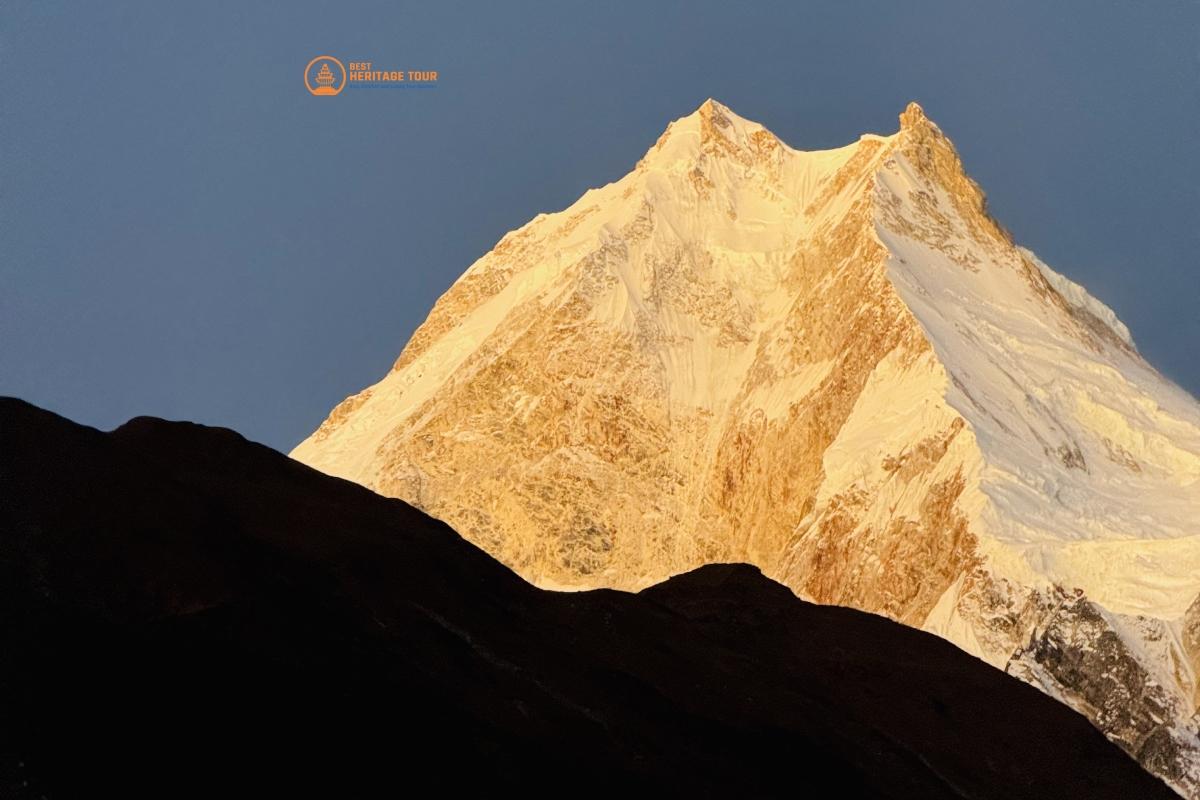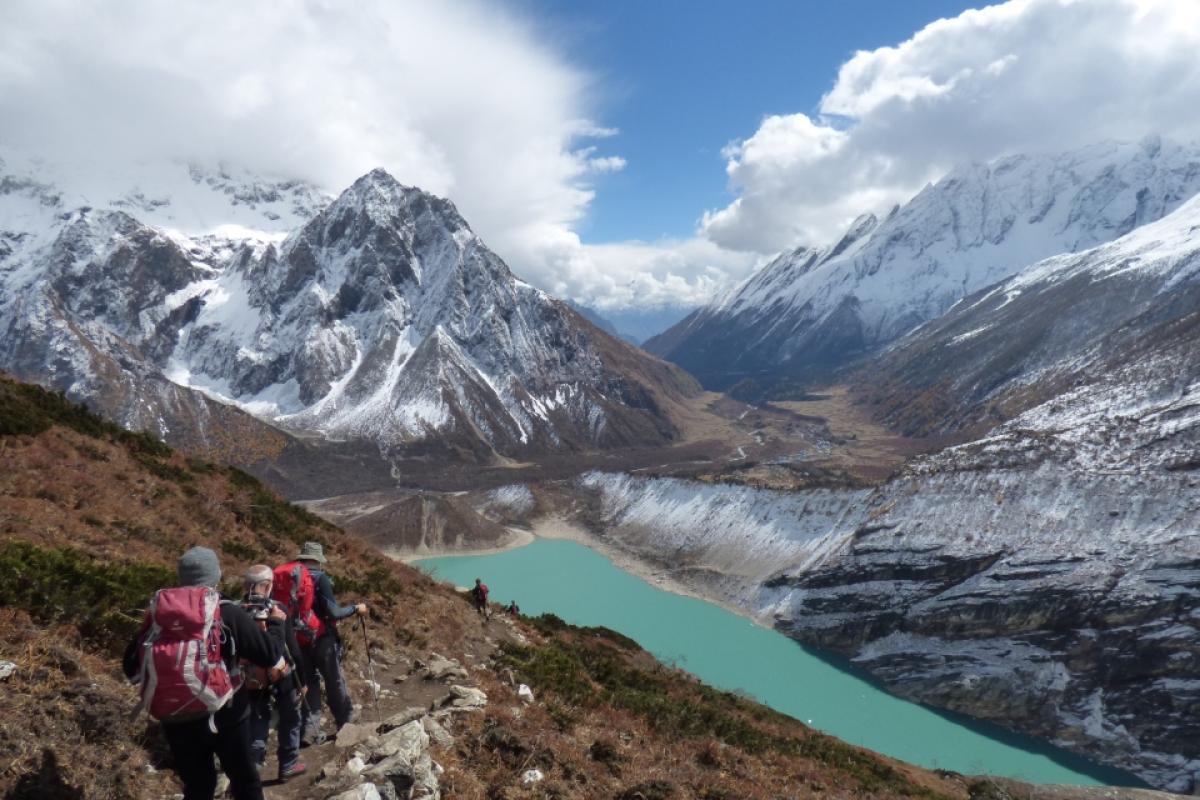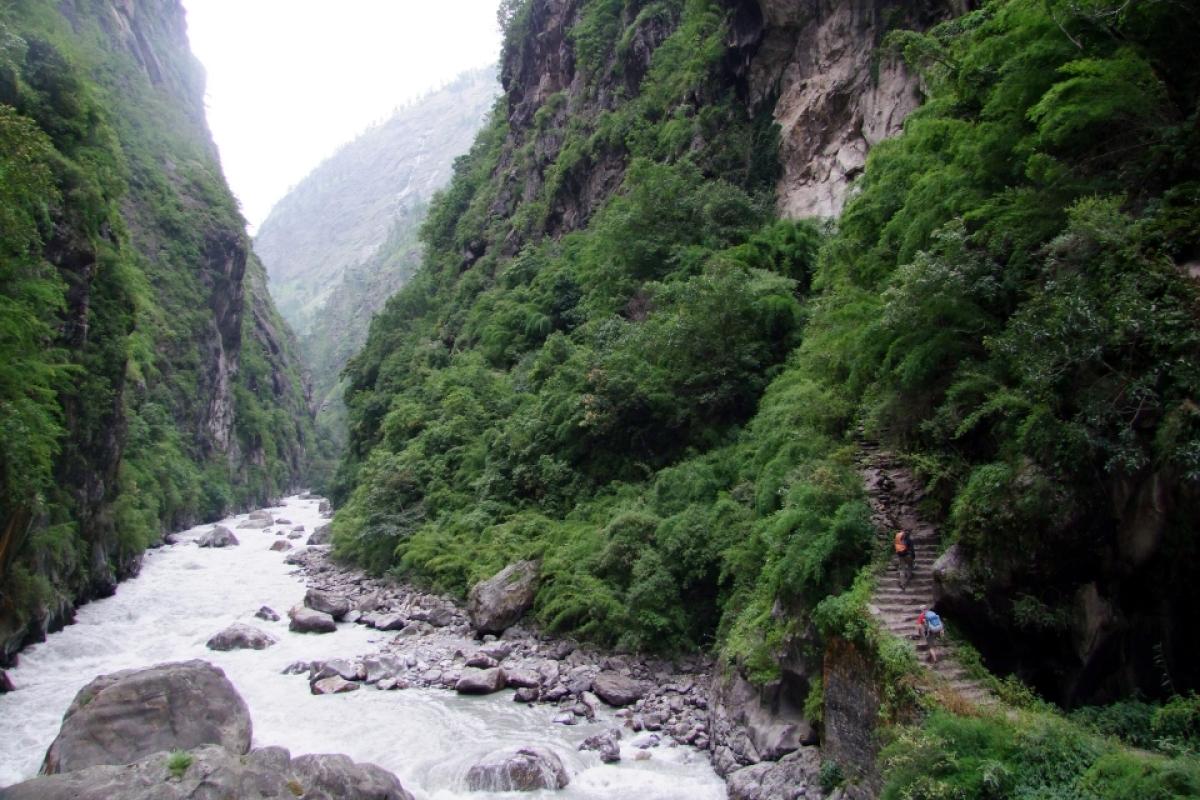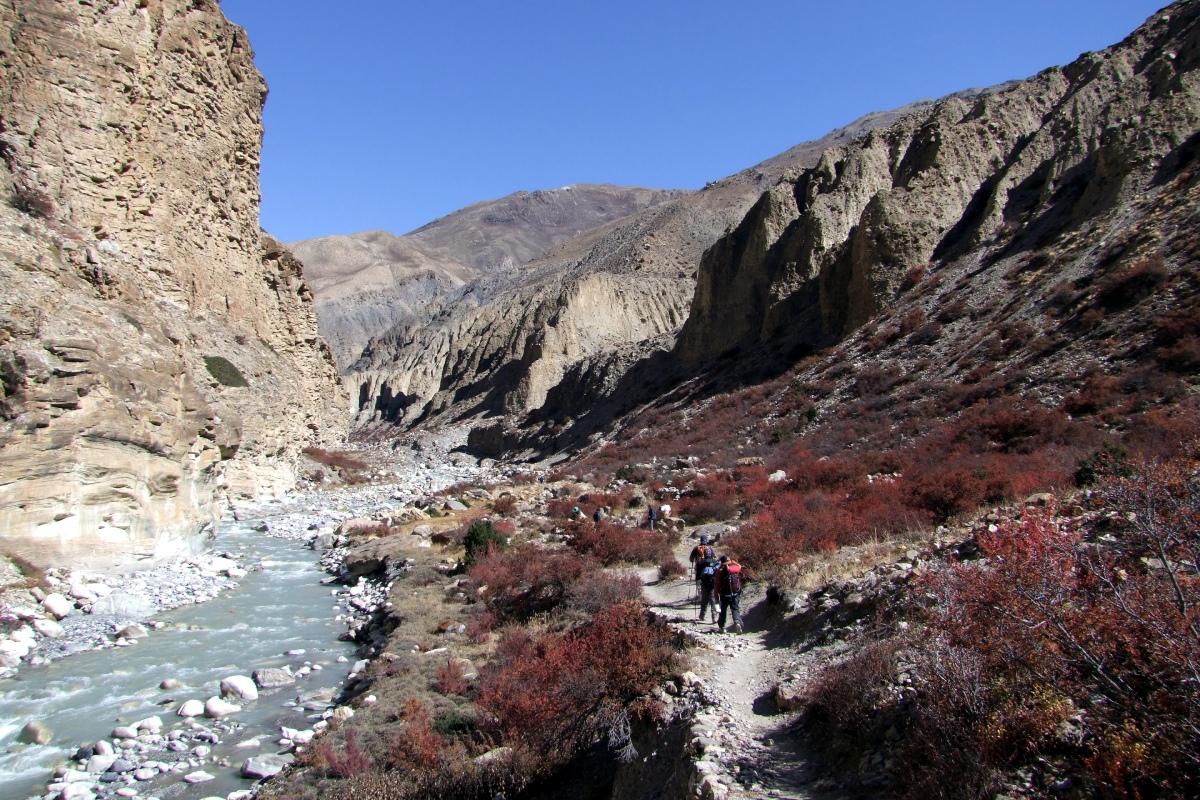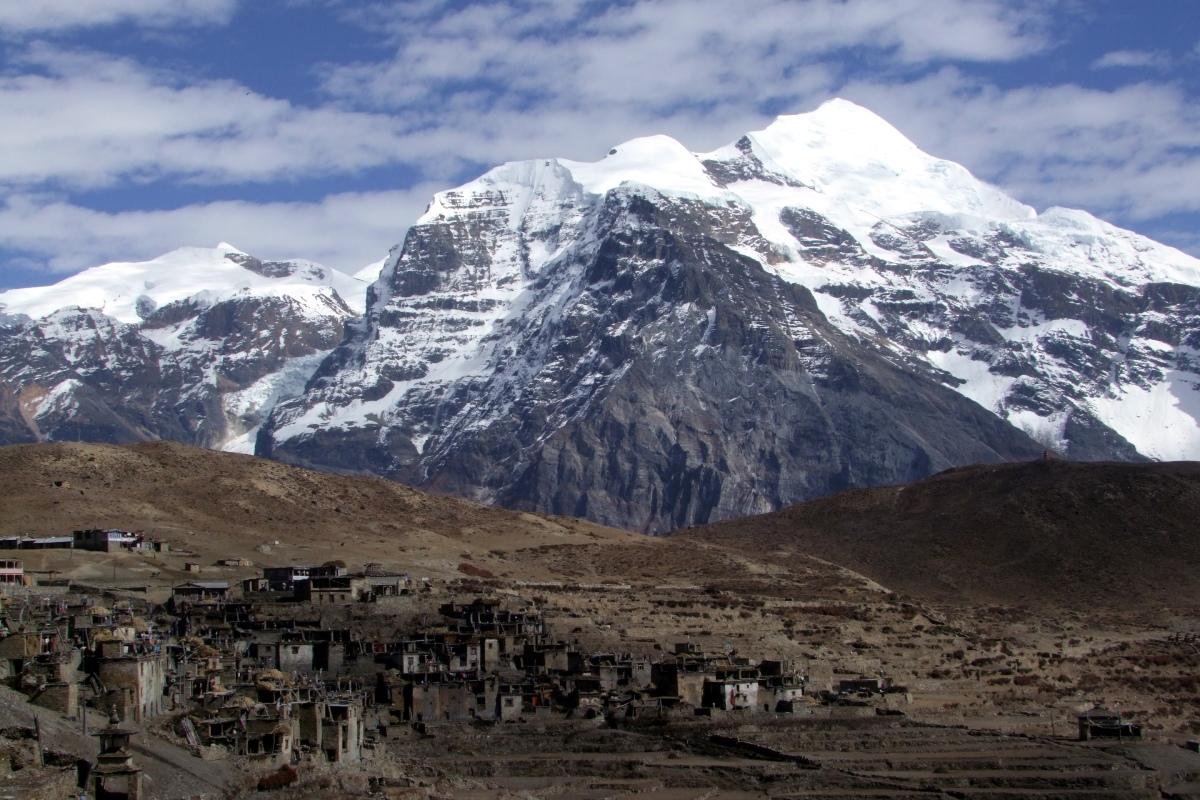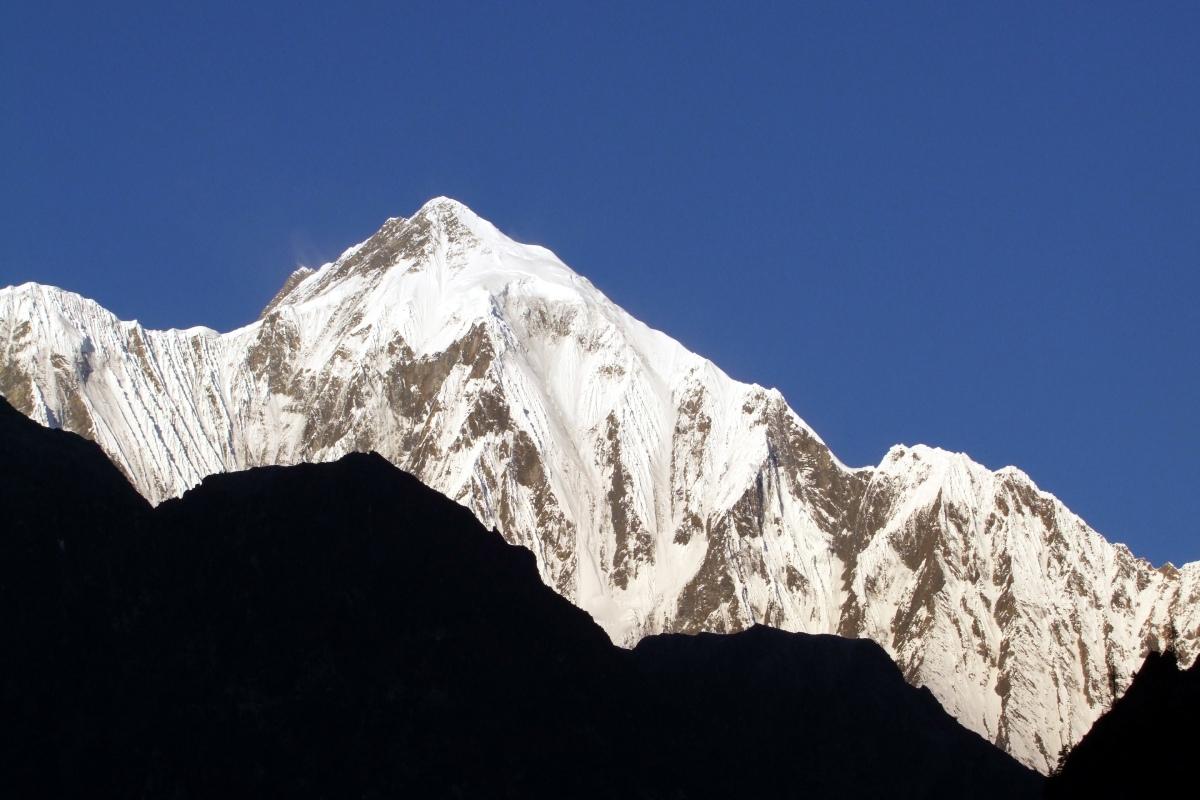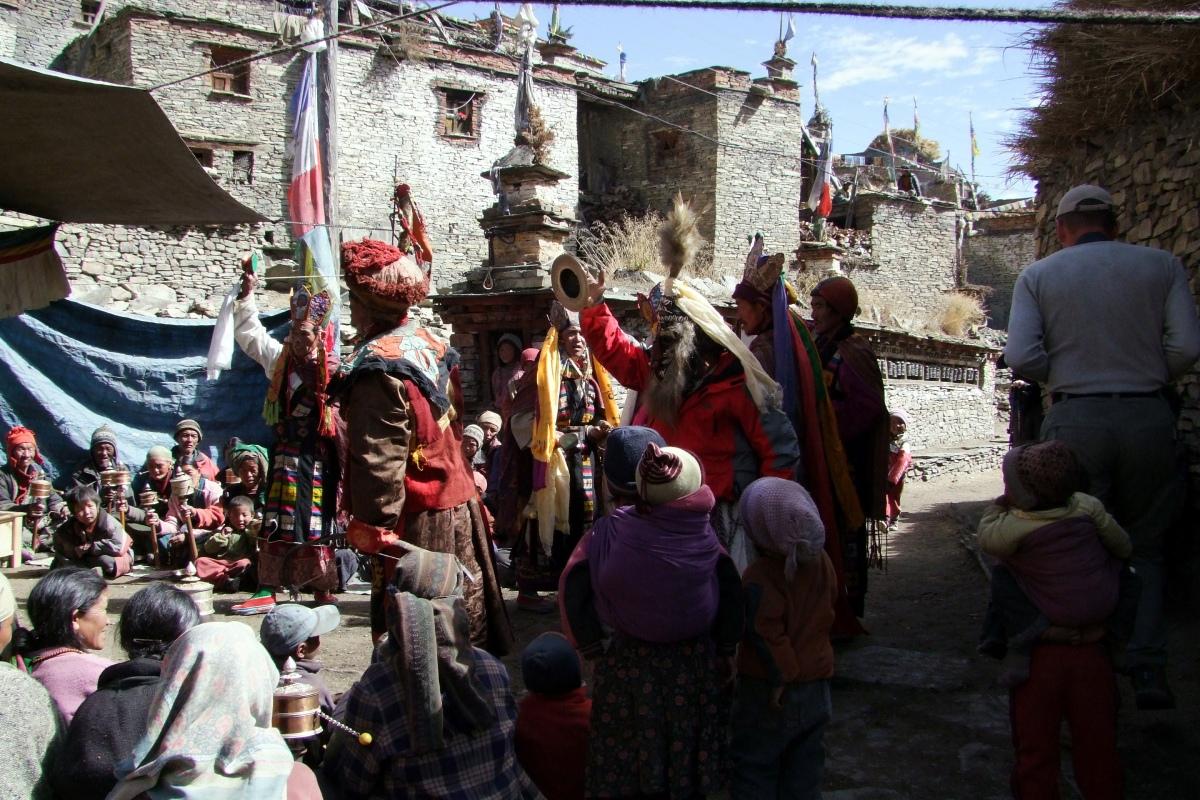Manaslu Circuit with Nar Phu Valley Trek Package - 22 Days
Insight on Manaslu Circuit with Nar Phu Valley Trek
The Manaslu Circuit with Nar Phu Valley Trek is an epic 22-day Himalayan adventure combining two of Nepal’s most remote and culturally rich trekking routes. This journey takes you from lush river valleys to rugged high passes, including the legendary Larkya La (5,160m) and Kang La (5,320m), offering breathtaking views of Manaslu, Annapurna, and surrounding peaks. You’ll explore ancient Tibetan-influenced villages, monasteries, and untouched valleys while experiencing diverse landscapes - from subtropical forests to alpine wilderness. Perfect for seasoned trekkers seeking both scenic beauty and cultural immersion, this trek promises an unforgettable, off-the-beaten-path experience.
Trip at a Glance
Key Highlights
- Cross the high passes of Larkya La and Kang La for unparalleled Himalayan panoramas.
- Trek remote trails far from crowds, immersing yourself in pristine natural beauty.
- Visit ancient Tibetan villages and monasteries rich in Buddhist culture and traditions.
- Traverse diverse landscapes from subtropical forests to alpine meadows and glaciers.
- Marvel at iconic peaks like Manaslu, Annapurna, and Pisang framed by clear mountain skies.
- Chance to Spot rare wildlife including blue sheep, Himalayan monal, and elusive snow leopards.
- Explore centuries-old monasteries such as Ribung and hidden gompas in Nar and Phu.
- Stay in local tea houses, experiencing authentic Himalayan hospitality and village life.
- Experience two legendary treks - the Manaslu Circuit and Nar Phu Valley - in one epic journey.
Benefits of booking with Best Heritage Tour
- Simple booking with multiple contact options including WhatsApp, Skype, and Zoom.
- Personalized trip discussions after booking to customize your trek.
- 24/7 phone support at +977-9851149197 / +977-9810043046 for any assistance.
- Health safety with pulse oximeter and first aid kit provided.
- Porter travel bags supplied for smooth trekking.
- Experienced local guides ensuring authentic cultural and safe trekking experiences.
- Optional sleeping bags and down jackets for extra comfort.
- Focus on sustainable and responsible tourism to protect local communities and environment.
- All-inclusive packages with hassle-free planning and memorable keepsakes.
Trip Overview
Embark on an unforgettable journey through Nepal’s most remote and breathtaking regions with the Manaslu Circuit & Nar Phu Valley Trek. This 22-day adventure combines two spectacular trekking routes, leading you from lush river valleys to towering Himalayan peaks, including the mighty Manaslu (8,163m), Nepal’s eighth highest mountain.
Beginning in the vibrant capital, Kathmandu, you’ll be immersed in rich cultural heritage before driving to Machha Khola to start your trek. Over the following days, experience diverse landscapes - from subtropical forests and terraced fields to alpine meadows and glacial valleys. Cross two challenging high passes, the Larkya La (5,160m) and Kang La (5,320m), both offering awe-inspiring panoramic views of Annapurna, Manaslu, and the surrounding Himalayas.
The trek also provides rare cultural insights as you visit traditional Tibetan Buddhist villages such as Samagaon, Nar, and Phu, home to ancient monasteries, stone houses, and colorful prayer flags. Along the way, spot unique Himalayan wildlife including blue sheep, Himalayan monal pheasants, and possibly the elusive snow leopard.
With expert local guides, comfortable accommodations in well-managed tea houses, and a strong emphasis on safety and sustainability, this trek offers a perfect blend of adventure, cultural immersion, and natural beauty. Whether you’re an experienced trekker seeking a physical challenge or a culture enthusiast craving authentic Himalayan life, this journey promises a once-in-a-lifetime experience that you’ll cherish forever.
What You Can Expect on Manaslu Circuit with Nar Phu Valley Trek
1. Spectacular Mountain Views
Prepare to be amazed by breathtaking panoramas of some of Nepal’s highest peaks, including the towering Manaslu (8,163m), Annapurna range, and Pisang Peak. These snow-capped giants dominate the skyline and offer stunning photographic opportunities at every turn. Experience magical moments like golden sunrises over the mountains, dramatic cloud formations, and star-filled Himalayan nights that make this trek truly unforgettable.
2. Diverse Terrain
The Manaslu Circuit with Nar Phu Valley Trek takes you through a variety of landscapes, starting in lush subtropical forests rich with diverse plant and animal life. You’ll pass fertile terraced fields cared for by local farmers and fragrant rhododendron forests that burst into color in spring. As you ascend, the environment changes to alpine meadows, glacial moraines, and stark high-altitude deserts, showcasing the raw beauty and ecological diversity of the Himalayas.
3. Cultural Encounters
This trek offers a deep dive into traditional Tibetan Buddhist culture. Visit remote villages like Samagaon, Nar, and Phu, where ancient monasteries, prayer wheels, and colorful mani stones are part of daily life. Engage with friendly locals who preserve centuries-old customs, witness Buddhist rituals, and experience authentic mountain hospitality that enriches your journey beyond just natural beauty.
4. High Pass Crossings
A major highlight of the trek is crossing two challenging high mountain passes: Larkya La at 5,160 meters and Kang La at 5,320 meters. These passes provide not only a physical challenge but also reward trekkers with sweeping 360-degree views of the surrounding Himalayas. Standing atop these passes offers a sense of accomplishment and unparalleled vistas of glaciers, peaks, and valleys.
5. Wildlife Spotting
The trek traverses remote and pristine habitats where you can spot rare Himalayan wildlife. Keep an eye out for blue sheep grazing on steep slopes, the colorful Himalayan monal pheasant (Nepal’s national bird), and, with luck, the elusive snow leopard prowling its high-altitude domain. Bird watchers and nature lovers will find the diversity captivating.
6. Authentic Village Life
Overnight stays in traditional tea houses run by local families provide genuine insight into Himalayan mountain life. Experience warm hospitality, taste delicious homemade meals, and observe the daily routines of villagers who live in harmony with nature. These villages, often untouched by mass tourism, offer a peaceful retreat and cultural immersion.
7. Remote & Off-the-Beaten-Path
Unlike more popular trekking routes, this journey follows quiet trails far from the crowds, allowing you to enjoy solitude and the serenity of Nepal’s wilderness. The remote nature of the trek ensures a more intimate and personal adventure, with pristine landscapes and authentic cultural experiences waiting around every bend.
8. Breathtaking Natural Beauty
The trek features pristine glacial lakes, fast-flowing rivers, serene valleys, and dramatic mountain passes. The variety of natural scenery from dense forests to barren alpine plateaus, creates a stunning backdrop that changes daily, offering endless opportunities for photography, reflection, and connection with nature.
Are you ready for Manaslu Circuit with Nar Phu Valley Trek?
The Manaslu Circuit with Nar Phu Valley Trek is physically demanding and requires good fitness. You should be comfortable trekking 5 to 9 hours daily over varied terrain, including steep climbs and high-altitude passes above 5,000 meters. Prior experience with long hikes and moderate altitude is highly recommended, as the thin air can be challenging. Building cardiovascular endurance, leg strength, and stamina through regular exercise will help you handle the continuous ups and downs safely.
Mentally, this trek calls for resilience, patience, and a positive mindset. You’ll encounter unpredictable weather, remote conditions, and simple accommodations. Staying adaptable, calm, and open to embracing local culture will greatly enhance your experience. With proper physical training and mental preparation, this adventure is achievable for motivated trekkers seeking a rewarding and authentic Himalayan journey.
Itinerary
Your adventure begins as you land at Tribhuvan International Airport, where our representative from Best Heritage Tour greets you with a warm welcome. A comfortable private transfer will take you to your hotel in Thamel, Kathmandu’s vibrant tourist hub. After check-in, enjoy a welcome drink while we brief you about the trek, review your gear, and answer any last-minute questions. In the evening, savor a traditional Nepali dinner and get a taste of the rich culture awaiting you in the mountains.
We set out early for an 8-9 hour drive along winding roads that hug the banks of the Trishuli and Budhi Gandaki rivers. As the city fades behind, you’ll pass terraced rice fields, subtropical forests, and quaint roadside settlements. Occasional glimpses of snow peaks remind you of the adventure ahead. By late afternoon, we arrive in Machha Khola, a small riverside village where the sound of rushing water sets the tone for the trek to come.
The first day on foot introduces you to Nepal’s rugged Himalayan terrain. The trail follows the Budhi Gandaki through narrow gorges, across suspension bridges, and past small villages. You’ll weave through banana groves, waterfalls, and terraced farmlands before reaching Jagat, a charming stone-paved settlement marking the official entrance to the Manaslu Conservation Area.
Today’s path is varied - lush forests of pine and rhododendron, dramatic cliffs above the river, and open fields. We pass through Philim, known for its picturesque setting and welcoming locals, and Ekle Bhatti, a small resting point for trekkers. As the altitude rises, the air feels cooler and fresher. We arrive in Deng, a small but culturally rich village influenced by Tibetan traditions, where colorful prayer flags flutter above rooftops.
Leaving Deng, we ascend through alpine forests and cross several suspension bridges draped with prayer flags. Along the way, enjoy spectacular views of Shiringi Himal and surrounding snow peaks. Villages here reflect deep Buddhist roots, with intricately carved mani stones and chortens lining the trail. We reach Namrung, a well-known stop for its panoramic Himalayan vistas and stone houses built in traditional style.
The scenery changes dramatically as we pass the picturesque villages of Lihi and Sho, where chortens and barley fields decorate the landscape. The mighty Manaslu North and Naike Peak dominate the skyline. By afternoon, we arrive at Lho Gaon, home to the impressive Ribung Monastery. From here, the sunset over Mount Manaslu (8,163m) is nothing short of magical.
Today’s trail offers wide, scenic views of snow-draped Himalayan giants. We pass Shyala Village, surrounded by glaciers, high peaks, and yak pastures. The final stretch leads to Samagaon, one of the most iconic villages in the region. This traditional Tibetan-style settlement sits under the shadow of Manaslu and boasts rich Buddhist heritage, ancient monasteries, and stunning mountain backdrops.
Acclimatization is key before we move higher. Spend the day exploring Samagaon’s cultural treasures, including the centuries-old Pungyen Monastery and the sacred Birendra Lake, a turquoise glacial lake at the foot of Manaslu Glacier. You’ll also witness daily life in the village - prayer wheels spinning, yak herders at work, and the rhythmic chanting from monasteries.
For those feeling strong, an optional morning hike to Manaslu Base Camp (4,800m) offers an unforgettable close-up of the world’s eighth-highest peak. Alternatively, visit Pungyen Gompa, perched high above the valley. Later, we trek towards Mishima, a smaller settlement with panoramic Himalayan views.
We gradually ascend into high alpine terrain, leaving vegetation behind. The trail offers spectacular views of Naike Peak and the distant Larkya La Pass. Dharmasala, also called Larkya Phedi, is a simple but strategic overnight stop before the big pass crossing. The air is thin, and the temperature drops significantly, signaling the high Himalayan environment.
This is the most challenging yet rewarding day. We start early, climbing gradually to the Larkya La Pass - a high, snowy saddle offering breathtaking 360° Himalayan panoramas, including Himlung Himal, Cheo Himal, and Annapurna II. After soaking in the views, we descend through glacial valleys to reach the green pastures of Bhimtang.
We descend into lush forests, passing through Yak Kharka and the quaint village of Tilje. The warmer air, pine forests, and blooming rhododendrons feel refreshing after the high-altitude journey. By late afternoon, we reach Dharapani, where the Manaslu Circuit meets the Annapurna Circuit trail.
We leave the busier Annapurna route and follow the Nar Phu Valley trail towards Koto, a small village that serves as the gateway to the remote Nar and Phu region. The trail is peaceful, passing through pine forests and traditional settlements.
We follow a secluded trail along the Phu River, crossing several suspension bridges and climbing steadily. The scenery turns wilder, with rugged cliffs, waterfalls, and sparse vegetation. Meta is a windswept plateau village with sweeping mountain views and traditional stone houses.
The trail to Phu feels like a journey back in time. We pass abandoned Khampa settlement ruins, chortens, and ancient Buddhist gates. On arrival, Phu Village reveals its medieval charm - mud-brick houses stacked on a hillside and views over vast, barren valleys framed by high peaks.
We spend a day immersing ourselves in Phu’s Tibetan culture. Visit the ancient Tashi Lakhang Monastery, meet locals spinning yak wool, and explore high ridges for spectacular photo opportunities. This is also an important rest day for acclimatization before crossing Kang La Pass.
We retrace part of our route before taking a high trail towards Nar Village, another remote gem with a vibrant cultural heritage. The villagers here maintain centuries-old traditions, and the surrounding mountains form a dramatic backdrop.
A challenging but exhilarating day as we climb to Kang La Pass, where jaw-dropping views of Annapurna II, Gangapurna, and Tilicho Peak await. The descent to Ngawal offers a change of scenery, with more greenery and a warmer climate.
We leave the remote trails and enjoy a scenic jeep ride to Chame, a bustling village and the district headquarters of Manang. Surrounded by pine forests and towering cliffs, Chame offers hot springs and beautiful river views.
We descend further by jeep along the Marsyangdi River valley. The drive takes us through lush hills, waterfalls, and small villages until we reach Besisahar, the administrative center of Lamjung District.
We complete our circuit with a scenic drive back to Kathmandu, passing river valleys, terraced hillsides, and vibrant towns. Upon arrival, enjoy a hot shower, some shopping in Thamel, and a farewell dinner with our team.
Your incredible journey in the Himalayas comes to an end. Our team will transfer you to Tribhuvan International Airport for your onward flight, carrying memories of two remote and spectacular trekking regions.
What is included?
- All necessary trekking permits (Manaslu Restricted Area Permit, ACAP, Nar Phu Restricted Area Permit, TIMS card)
- Airport transfers on arrival and departure (Tribhuvan International Airport, Kathmandu)
- All ground transportation during the trek (private vehicles, jeep rides)
- Accommodation in Kathmandu (hotel) before and after the trek
- Tea house/lodge accommodations during the trek
- Three meals a day (breakfast, lunch, dinner) while trekking
- Experienced, licensed trekking guide and support staff
- Travel and Medical Insurance for all the support staff
- Support Staff salary and daily allowances
- First aid kit and basic medical support during the trek
- Welcome and farewell dinners in Kathmandu
What is not included?
- International airfare to/from Nepal
- Nepal visa fees and processing
- Personal trekking gear and clothing
- Travel insurance (mandatory for all trekkers)
- Tips for guides, porters, and support staff
- Meals and drinks in Kathmandu
- Personal expenses such as laundry, phone calls, snacks, or souvenirs
- Extra accommodation or meals due to flight delays or early arrivals/departures
- Any rescue or evacuation costs in case of emergency
- Any things that is not mention in Itinerary and Included section.
- All government taxes 13%, SSF, and 10% service charges
Route Map
Equipment
Clothing
-
Base Layer (moisture-wicking):
-
Long-sleeve thermal shirt
-
Thermal leggings or long underwear
-
Moisture-wicking socks (avoid cotton)
-
-
Mid Layer (insulation):
-
Fleece jacket or lightweight down jacket
-
Insulated pants (optional for very cold conditions)
-
Extra pairs of wool or synthetic socks
-
-
Outer Layer (protection from elements):
-
Waterproof and windproof jacket (with ventilation zips)
-
Waterproof pants (Gore-Tex or similar)
-
Warm hat or beanie for insulation
-
Neck gaiter, balaclava, or scarf for face protection
-
Gloves (preferably insulated)
-
-
Additional Clothing & Footwear:
-
Hiking boots, well broken-in and waterproof
-
Gaiters to protect against mud and snow
-
Hat or cap for sun protection
-
Optional camouflage clothes (if needed)
-
Health & Safety Equipment
-
First aid kit (include blister treatment, painkillers, altitude sickness meds)
-
Altitude sickness medication
-
Sunscreen (high SPF) and lip balm
-
Insect repellent
-
UV-protection sunglasses
-
Oxygen canister (optional but recommended for high passes)
-
Hydration tablets
-
Water purification system (tablets, filter, or UV purifier)
Gear & Accessories
-
Main backpack (40-60L) with rain cover
-
Daypack (20-30L) for daily essentials
-
Sleeping bag rated to at least -10°C (rentals often available)
-
Trekking poles (adjustable)
-
Headlamp with extra batteries
-
Water bottles or hydration system (minimum 2 liters)
-
Camera or smartphone with power bank for charging
Miscellaneous & Personal Items
-
Travel documents (passport, permits, insurance, photocopies)
-
Cash in Nepalese Rupees for purchases, tips, and emergencies
-
Trash bags to carry out your waste (eco-friendly trekking)
-
Notebook and pen (for journaling or notes)
-
Personal toiletries (biodegradable soap, toothbrush, towel, etc.)
Trip Info
Best Time for the Manaslu Circuit with Nar Phu Valley Trek
The ideal times to embark on the Manaslu Circuit with Nar Phu Valley Trek are during the pre-monsoon (spring) and post-monsoon (autumn) seasons.
-
Spring (March to May): This season offers mild temperatures, blooming rhododendrons, and clear skies, making it perfect for trekking and photography. Wildlife activity is high, and the landscapes come alive with vibrant colors. The warming weather and increasing daylight make the trek comfortable, though late spring can get busier as trekking season peaks.
-
Autumn (September to November): Considered the best trekking season, autumn brings stable weather, crisp mountain views, and comfortable temperatures. The skies are usually clear, offering spectacular panoramic vistas of Manaslu, Annapurna, and surrounding peaks. Trails are dry and safe, and local festivals add cultural richness to your journey.
While the winter months (December to February) are colder with possible snow on high passes, some experienced trekkers still choose this time for solitude and unique snowy landscapes. However, cold temperatures, shorter daylight, and potential snow closures can make trekking difficult and less accessible.
The monsoon season (June to August) is generally avoided due to heavy rainfall, slippery trails, and increased risk of landslides, though the region’s lush greenery is at its peak. Cloud cover often obscures mountain views, and travel disruptions are common, making this season less suitable for trekking.
Planning your trek during spring or autumn ensures optimal weather, safety, and the best overall experience on this stunning Himalayan adventure.
Permits Required for the Manaslu Circuit with Nar Phu Valley Trek
To trek the Manaslu Circuit and Nar Phu Valley, you must obtain several official permits to comply with Nepal’s regulations and ensure your safety:
-
Manaslu Restricted Area Permit: This is mandatory for trekking within the Manaslu Conservation Area. It helps regulate visitor numbers and protect the fragile environment. The permit fee varies depending on the season and duration of stay.
-
Annapurna Conservation Area Permit (ACAP): Required for parts of the trek that pass through the Annapurna Conservation Area, such as Dharapani and surrounding regions.
-
Trekkers’ Information Management System (TIMS) Card: Issued by the Nepal Tourism Board, this card is compulsory for all trekkers in Nepal and helps track and manage visitor safety.
-
Nar Phu Valley Restricted Area Permit: As Nar and Phu are in a restricted area, this permit is essential and is issued by the Department of Immigration in Kathmandu or at the entry point to the restricted zone.
Best Heritage Tour handles all permits and fees, ensuring hassle-free processing before your trek begins. Always carry your permits with you during the trek, as they may be checked by park officials and local authorities along the route.
A Typical Day on the Manaslu Circuit with Nar Phu Valley Trek
A typical day on the Manaslu Circuit with Nar Phu Valley Trek starts early, usually around 6 to 7 AM, with a hearty breakfast at the tea house or lodge. After packing up and checking your gear, the day’s trek begins, ranging from 5 to 9 hours of walking through diverse landscapes - lush forests, terraced fields, and high mountain passes. Along the way, you’ll stop for lunch in local villages or rest points, enjoying simple but nutritious meals.
Trekking continues in the afternoon, offering stunning views and cultural encounters, before arriving at your next tea house or lodge by late afternoon. Evenings are spent relaxing, sharing stories with fellow trekkers, and savoring a warm dinner, often featuring traditional Nepali dishes. You’ll have time to rest, rehydrate, and prepare for the next day’s adventure, usually going to bed early to recover energy for the trek ahead.
Accommodation and Meals
During the Manaslu Circuit & Nar Phu Valley Trek, accommodation is primarily in traditional tea houses and lodges along the trekking route. These tea houses are family-run, cozy, and provide a warm, authentic mountain atmosphere. While basic compared to hotels, most offer comfortable beds, shared bathrooms, and communal dining areas with stunning mountain views. In larger villages, you may find slightly better facilities, including Wi-Fi and hot showers, but these are limited and often come at an extra cost.
Meals on the trek typically consist of simple, nutritious, and locally prepared dishes designed to keep you energized. Breakfast usually includes options like porridge, eggs, toast, and tea or coffee. Lunch and dinner often feature Dal Bhat (Nepali lentil soup with rice), noodles, soups, vegetables, and occasional meat dishes depending on availability. Fresh fruits and snacks can be bought in larger villages but are limited in remote areas. It is recommended to stay hydrated with boiled or purified water, and tea or hot lemon drinks are commonly served to help with acclimatization.
Special dietary needs can often be accommodated if communicated in advance, but it’s advisable to carry some personal snacks and energy bars for longer trekking days. Overall, the meals and accommodation provide a comfortable, culturally immersive experience that complements the natural beauty and adventure of the trek.
Physical Fitness for the Manaslu Circuit with Nar Phu Valley Trek
The Manaslu Circuit with Nar Phu Valley Trek is physically demanding, involving long days of trekking over uneven, steep, and high-altitude terrain. Trekkers need strong cardiovascular endurance, leg strength, and overall stamina to handle 5 to 9 hours of walking daily, including challenging ascents and descents. Mental resilience and the ability to adapt to changing weather and altitude are equally important to ensure a safe and enjoyable trek.
Tips to Prepare Physically:
- Engage in aerobic exercises like hiking, jogging, cycling, or swimming 3-4 times a week
- Incorporate strength training focused on legs, core, and back muscles
- Practice hiking with a loaded backpack to simulate trek conditions
- Include balance and flexibility exercises like yoga or Pilates
- Gradually increase the intensity and duration of workouts over several weeks
- Train at higher altitudes if possible, or use breathing exercises to improve lung capacity
- Maintain a healthy diet and stay hydrated during training
- Consult a doctor about altitude sickness prevention and general fitness
Health and Safety on the Manaslu Circuit with Nar Phu Valley Trek
Health and safety are paramount on the Manaslu Circuit with Nar Phu Valley Trek due to its remote location and high-altitude challenges. Altitude sickness is one of the most significant risks, so proper acclimatization days and gradual ascent rates are essential. Always listen to your body and communicate any symptoms such as headaches, nausea, or dizziness to your guide immediately. Staying hydrated and avoiding alcohol can also help reduce the risk of altitude sickness.
The trek involves variable weather and rugged terrain, so it’s crucial to be prepared for sudden weather changes and slippery or uneven paths. Wearing appropriate clothing, using trekking poles, and following your guide’s instructions will help prevent injuries. Carry a well-stocked first aid kit and consider travel insurance that covers high-altitude trekking and emergency evacuation. Lastly, respect local customs and environmental regulations to ensure a safe and responsible trekking experience.
Travel Insurance (Mandatory)
Travel insurance is mandatory for the Manaslu Circuit with Nar Phu Valley Trek to protect against unforeseen events such as medical emergencies, trip cancellations, lost luggage, or evacuation due to altitude sickness. Make sure your insurance policy specifically covers high-altitude trekking (above 4,000 meters) and includes emergency helicopter rescue and medical evacuation services. Having comprehensive travel insurance provides peace of mind and ensures you receive timely and appropriate care if needed during this remote Himalayan adventure.
Booking and Payment
Booking your Manaslu Circuit with Nar Phu Valley Trek with Best Heritage Tour is simple and secure. To confirm your reservation, a 10% deposit of the total package cost is required. After booking, you’ll receive an online trip discussion to customize your experience and have all your questions answered. We offer multiple communication channels - email, WhatsApp, Facebook, WeChat, Viber, Skype, and Zoom to keep you connected with our expert team. Payments can be made smoothly through various secure methods, and our 24/7 support team is always available by phone to assist you before and during your trek, ensuring a hassle-free and confident journey from start to finish.
Last-Minute Bookings
While booking in advance is recommended, Best Heritage Tour also accommodates last-minute bookings. For these, full payment (100% of the trip price) is required at least 24 hours before the trek’s departure. We strive to offer trekking tours year-round, but please understand that we cannot be held responsible for delays caused by uncontrollable factors such as weather conditions or unavailable accommodations.
For more information or to make a last-minute booking, please contact us at +977-9851149197 / +977-9810043046 or email info@bestheritagetour.com.
Trip Extension Options
If you wish to extend your adventure beyond the Manaslu Circuit with Nar Phu Valley Trek, Best Heritage Tour offers several exciting trip extension options. You can explore nearby trekking routes like the Annapurna Circuit, Mustang region, or even Everest Base Camp for a broader Himalayan experience. Additionally, cultural tours around Kathmandu Valley or relaxing stays at Nepal’s scenic lakeside towns like Pokhara can be arranged. Our team will help customize your itinerary to suit your interests, schedule, and fitness level, ensuring a seamless and memorable extension to your journey.
FAQ's
The Manaslu Circuit & Nar Phu Valley Trek is an adventurous high-altitude trek in Nepal that showcases the breathtaking beauty of the Himalayas. It combines the rugged landscapes of the Manaslu region with the cultural richness of the remote Nar Phu Valley. Trekkers experience panoramic views of Mt. Manaslu, traditional Tibetan Buddhist villages, and pristine natural environments rarely touched by tourists.
This trek usually lasts around 21 to 22 days, covering roughly 230 kilometers of mountainous terrain. The duration allows for proper acclimatization, rest days, and exploration of unique cultural sites. This timeframe also ensures trekkers can safely cross high passes like Larkya La and Kang La.
The trek is considered moderate to challenging due to the combination of long trekking days, high altitudes, and uneven terrain. It demands a good level of physical fitness and mental endurance. Trekkers should be prepared for altitude changes and varying weather conditions.
While beginners with good physical fitness can attempt parts of the trek, the full route is generally recommended for experienced trekkers. The high passes and lengthy trekking days require stamina and proper acclimatization. It is advisable for beginners to train beforehand and consider hiring experienced guides.
The best seasons for this trek are spring (March to May) and autumn (September to November), when the weather is stable and skies are clear. These periods offer mild temperatures, excellent mountain views, and vibrant rhododendron blooms in spring. Summer (monsoon) is generally avoided due to heavy rain, while winter can be very cold and snowy.
Key highlights include crossing the dramatic Larkya La Pass, exploring ancient Tibetan Buddhist villages, and witnessing diverse landscapes from lush forests to barren high-altitude deserts. Trekkers also enjoy opportunities to spot unique Himalayan wildlife such as blue sheep and Himalayan monal pheasants. The blend of cultural immersion and natural beauty makes this trek a unique Himalayan experience.
Yes, the Manaslu region is designated as a restricted area to protect its fragile environment and cultural heritage. Special permits are required to enter and trek in this region, which helps regulate tourism and preserve local traditions. Nar Phu Valley also has access regulations to maintain its pristine condition.
Trekkers must obtain the Manaslu Restricted Area Permit, Annapurna Conservation Area Permit (ACAP), and a Trekker Information Management System (TIMS) card for Nar Phu Valley. These permits help protect natural and cultural resources and ensure trekkers’ safety. They are typically arranged by Best Heritage Tour for you.
Permits can be acquired through authorized trekking agencies like Best Heritage Tour or directly at the Nepal Tourism Board in Kathmandu. Agencies often handle the paperwork to streamline the process and reduce hassle for trekkers. It’s advisable to secure permits in advance, especially during peak trekking seasons.
A licensed guide is mandatory for the Manaslu Circuit as it lies in a restricted area where independent trekking is not allowed. For Nar Phu Valley, having a local guide is strongly recommended to navigate the complex terrain and respect local customs. Guides also ensure safety, provide cultural insights, and assist in emergencies.
There are no strict age or health restrictions, but trekkers should be in good physical condition to handle altitudes exceeding 5,000 meters. High altitude can affect individuals differently, so proper acclimatization and health precautions are crucial. Those with pre-existing medical conditions should consult a doctor before undertaking the trek.
The highest point is the Larkya La Pass at 5,160 meters (16,930 feet), which offers breathtaking views but demands good physical and mental preparation. Crossing this pass is considered the highlight and challenge of the trek. Proper acclimatization days before attempting the pass are essential to minimize altitude sickness risks.
While solo trekking is not possible and it is safer and more enjoyable to travel with a guide or in a group due to the remote terrain and permit requirements. Solo trekkers may face challenges navigating unfamiliar areas and handling emergencies alone. Guides also help facilitate cultural interactions and logistics.
Group sizes usually range from small private groups of 2 to 6 trekkers to larger groups up to 12 participants. Smaller groups allow for personalized attention from guides and better flexibility. Best Heritage Tour can accommodate both private and group bookings based on your preferences.
Yes, the trek passes through several traditional Tibetan Buddhist villages where trekkers can visit monasteries, observe local festivals, and experience authentic hospitality. This cultural exchange enriches the trekking experience and supports local livelihoods. Interaction with locals also offers insight into ancient Himalayan lifestyles.
Internet and phone connectivity are very limited and unreliable in remote areas, though some larger villages may offer paid Wi-Fi services. Mobile signal depends on your service provider and is often unavailable in high-altitude or isolated sections. It’s best to prepare for a digital detox and enjoy the natural surroundings.
The trek is very remote and off the beaten path, with minimal tourist traffic compared to popular routes like Annapurna or Everest. This remoteness ensures solitude and untouched natural beauty but also means limited infrastructure and amenities. Trekkers should be prepared for rugged conditions and limited emergency services.
Wildlife sightings may include Himalayan blue sheep (bharal), musk deer, Himalayan monal pheasants, and occasionally red pandas or elusive snow leopards in higher altitudes. Bird watchers will enjoy the diverse avian species in rhododendron forests and alpine meadows. Respect for wildlife and distance is encouraged to avoid disturbing their natural habitat.
Trekking during local festival times such as Lhosar (Tibetan New Year) or Mani Rimdu offers a rare chance to witness vibrant traditional celebrations. These festivals include colorful rituals, dance, and religious ceremonies at monasteries along the route. Participating respectfully in these events enriches the cultural experience of the trek.
Accommodation along the trek consists mostly of family-run tea houses and lodges that provide basic but comfortable rooms. Facilities vary from simple single or double rooms with shared bathrooms to slightly more equipped lodges in larger villages. Staying in these traditional tea houses allows trekkers to experience local hospitality and support village economies.
Tea houses generally maintain reasonable hygiene standards given the remote location, but conditions can be rustic compared to urban hotels. Cleanliness can vary, so it’s best to bring personal hygiene supplies like wet wipes and hand sanitizer. Despite modest facilities, the warmth of local hospitality often makes up for limited comforts.
Hot showers are available only in some larger villages and guesthouses and usually require an additional fee. In smaller or remote settlements, showers are often cold due to limited water heating infrastructure. Carrying a small towel and practicing good hygiene is recommended to stay comfortable.
Meals typically include traditional Nepali dishes such as Dal Bhat (lentil soup with rice), noodles, soups, and vegetable curries. Depending on availability, some lodges may offer meat dishes like chicken or yak, but vegetarian options are widely available. The food is usually fresh and homemade, offering a taste of authentic mountain cuisine.
Yes, vegetarian and vegan meals can be accommodated at most tea houses, especially if informed in advance. However, choices may be limited in smaller villages, so it’s helpful to carry some personal snacks or supplements. The staple Dal Bhat is naturally vegetarian and provides balanced nutrition.
Special dietary requests such as gluten-free or allergy-sensitive meals can be arranged with prior notice by Best Heritage Tour. Due to limited resources in remote areas, it is advisable to bring some specialty foods with you. Communicating your needs early helps ensure a smooth dining experience.
Bottled water is occasionally available but is expensive and environmentally discouraged. Trekkers are strongly recommended to use water purification tablets or filters to drink safely from local water sources. Staying hydrated with clean water is essential for health and altitude acclimatization.
Food is generally safe when freshly prepared and cooked thoroughly, but it’s wise to avoid raw or undercooked items like salads or unpeeled fruits. Eating at reputable tea houses reduces the risk of foodborne illness. Carrying hand sanitizer and eating where hygiene is visibly maintained can further minimize risks.
Yes, carrying energy bars, nuts, dried fruits, and other high-calorie snacks is highly recommended for energy boosts during long trekking days. These are especially useful between meals or when appetite is reduced due to altitude. Packing some familiar snacks can also provide comfort.
Alcoholic drinks like local beer, spirits, or imported beverages are available in some larger villages but are generally expensive and limited. Consuming alcohol at high altitude is not recommended as it can worsen dehydration and altitude sickness. It’s best to drink in moderation and focus on hydration.
Typically, three meals - breakfast, lunch, and dinner are provided each day at tea houses and lodges. This ensures trekkers have enough energy to sustain long days on the trail. Some packages also include snacks and hot drinks.
Yes, breakfast is served daily and usually includes options like porridge, eggs, toast, or traditional Nepali dishes. A nutritious breakfast is essential to fuel the morning’s trek and maintain energy levels. Early starts are common, so meals are prepared to accommodate this.
Snacks such as biscuits, chocolates, and instant noodles are available in larger villages but can be limited and more expensive than in cities. Small shops usually stock basic items, but it’s wise to carry your preferred snacks for convenience. Availability may fluctuate based on season and location.
Yes, all meals during the trek are provide for a hassle-free experience. Best Heritage Tour clearly mentioned which meals are covered and if any additional costs apply. Meals in Kathmandu or side excursions are not included.
A good to excellent level of physical fitness is required to comfortably complete this trek, given the long daily walks and high-altitude challenges. Cardiovascular endurance, leg strength, and stamina are crucial to manage steep ascents and descents. Mental preparedness to handle fatigue and changing weather is also important.
Begin training several months in advance with aerobic exercises such as hiking, running, cycling, or swimming to build endurance. Include strength training focusing on legs, core, and back, and practice hiking with a weighted backpack to simulate trekking conditions. Gradually increase the duration and intensity of workouts to avoid injury.
Though not mandatory, previous trekking experience at moderate altitudes significantly improves your chances of success and enjoyment. Experience helps with pacing, recognizing altitude sickness symptoms, and managing logistics. Beginners should prepare thoroughly and consider shorter treks before attempting this route.
Daily trekking times vary between 5 and 9 hours, depending on the route section, weather, and individual pace. Longer days typically occur when crossing passes or transitioning between remote villages. Rest days are scheduled to aid acclimatization and recovery.
Yes, the itinerary includes acclimatization rest days in villages such as Samagaon and Phu to help trekkers adjust to altitude. These days may involve light hikes or cultural exploration at a relaxed pace. Rest days reduce the risk of altitude sickness and enhance the overall trekking experience.
Proper acclimatization involves ascending slowly, taking rest days, staying well-hydrated, and avoiding alcohol or overexertion. Listening to your body and communicating symptoms of altitude sickness early is crucial. Guides often recommend a “climb high, sleep low” approach to help your body adapt.
You should pack layered clothing suitable for varying weather, including moisture-wicking base layers, insulating mid-layers, and waterproof outer layers. Temperatures can range from warm in lower valleys to freezing at high altitudes, so flexibility is key. Don’t forget warm hats, gloves, and sturdy trekking boots for comfort and protection.
Yes, trekking poles are highly recommended as they provide stability on uneven terrain and reduce strain on knees during descents. They also help maintain balance on slippery or rocky trails, especially when crossing high passes. Using poles can improve your trekking efficiency and reduce fatigue.
A good-quality, warm sleeping bag rated for sub-zero temperatures is essential, as nights at high altitudes can be very cold. Most tea houses provide blankets, but personal sleeping bags offer extra warmth and hygiene. Best Heritage Tour can provide you a sleeping bag or help you to rent it.
Yes, carrying water purification tablets or a portable filter is advisable to ensure safe drinking water along the route. While boiled or bottled water is sometimes available, purification methods reduce the risk of waterborne illnesses. Staying hydrated with clean water is critical at altitude.
A trekking backpack of 40-60 liters capacity is ideal to carry essentials such as clothing, gear, snacks, and water. It should have comfortable padded straps, good back support, and rain cover. Many trekkers use porter services to carry heavier loads but keep a daypack for daily needs.
Gaiters are helpful to protect your lower legs and boots from mud, snow, and small debris on the trail. They are particularly useful during the spring or autumn seasons when snow or rain can make trails slippery. While optional, gaiters add comfort and protect your footwear.
Bringing a basic first aid kit including altitude sickness medication, pain relievers, blister treatment, and sunscreen is essential. A pulse oximeter can help monitor oxygen saturation at altitude, and insect repellent may be useful in lower forested areas. Having these items ensures you’re prepared for minor health issues.
Yes, warm insulated gloves and hats are crucial as temperatures can drop significantly, especially during early mornings, evenings, and at higher elevations. Protecting extremities from cold helps prevent frostbite and maintains comfort. Layering is recommended for optimal warmth.
Yes, Kathmandu and Pokhara have several rental shops offering trekking gear like sleeping bags, down jackets, and boots. Renting can reduce your packing load but ensure the equipment is in good condition before use. Booking gear rentals through Best Heritage Tour can simplify arrangements.
A down jacket is highly recommended to provide insulation against cold temperatures encountered above 3,500 meters. It’s lightweight, compressible, and very effective at retaining body heat. Even if you rent gear, having a down jacket is important for high-altitude comfort.
There is no fixed daily limit, but the restricted area status regulates trekking numbers through permits and controlled entry points. This helps prevent overcrowding and reduces pressure on local resources. Booking early is advised to ensure availability during peak seasons.
Yes, a separate Trekker Information Management System (TIMS) card is required for trekking in the Nar Phu Valley. This ensures trekkers are registered and accounted for in this remote and sensitive area. Best Heritage Tour assist in securing this permit.
Photography is generally allowed in public areas and landscapes, but always ask permission before photographing people or religious ceremonies. Some monasteries may have restrictions on photography inside. Respecting privacy and cultural sensitivities is important.
Yes, trekkers often extend their journey by visiting areas like Annapurna, Tilicho Lake, or visiting Kathmandu for cultural tours. Extensions allow deeper exploration of Nepal’s diverse landscapes and cultures. Consult Best Heritage Tour to customize your itinerary.
Booking is easy and straightforward via Best Heritage Tour’s website, email, or direct contact numbers. After initial inquiry, the team assists with itinerary customization, permits, and all logistics. A 10% deposit secures your spot, with flexible payment options available.
Yes, porters are available through Best Heritage Tour to carry your heavy luggage, allowing you to trek comfortably. Porters are given travel bags to protect your belongings and ensure smooth transport. Hiring porters also supports local employment.
Travel insurance is not included but is mandatory; Best Heritage Tour recommends all trekkers obtain comprehensive coverage before departure. This includes coverage for medical emergencies, evacuation, and trip cancellations. They can guide you on insurance options suitable for Himalayan trekking.
Best Heritage Tour has a transparent cancellation policy; refunds depend on timing and non-recoverable costs such as permits. We recommend purchasing travel insurance to cover unforeseen cancellations.
Yes, we assess individual health conditions during booking and tailor the trek accordingly. We advise necessary precautions and can provide additional medical equipment or slower pacing. Your safety and comfort are our priorities throughout the journey.
We have emergency protocols in place, including immediate medical attention, evacuation arrangements, and communication with health facilities. Guides carry first aid kits and pulse oximeters to monitor trekkers’ health closely. Our 24/7 support line provides prompt assistance when needed.
Local people primarily speak Tibetan dialects and Nepali, with English commonly spoken by guides and in tea houses. Basic communication in English is usually sufficient for trekkers, while guides help bridge any language gaps. Learning simple Nepali greetings can enhance cultural interactions.
Charging facilities are available in larger villages and tea houses, usually for a small fee. Power can be intermittent, so carrying portable power banks is advisable. Solar chargers are also a good eco-friendly option for remote areas.
Wi-Fi is available occasionally in some lodges and teahouses, mostly in larger villages. Speeds can be slow and unreliable. For full digital detox, many trekkers choose to disconnect, enjoying the pristine natural environment.
Mobile coverage is limited but available in some larger villages and near telecommunications towers. Expect intermittent service and no coverage in remote sections. Satellite phones or local SIM cards can enhance connectivity but may be expensive.
Respect local customs by dressing modestly, removing shoes before entering homes or monasteries, and asking permission before photographing people. Avoid public displays of affection and be mindful of religious sites. Showing respect strengthens relationships with local communities.
You can find locally made handicrafts, prayer flags, woolen garments, and Buddhist artifacts in villages along the route. Purchasing from local artisans supports the economy and helps preserve traditional crafts. Always bargain respectfully.

